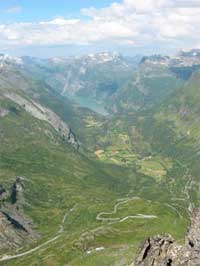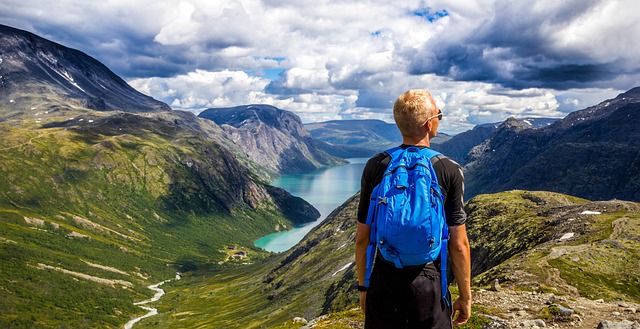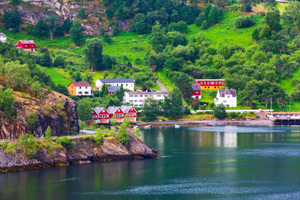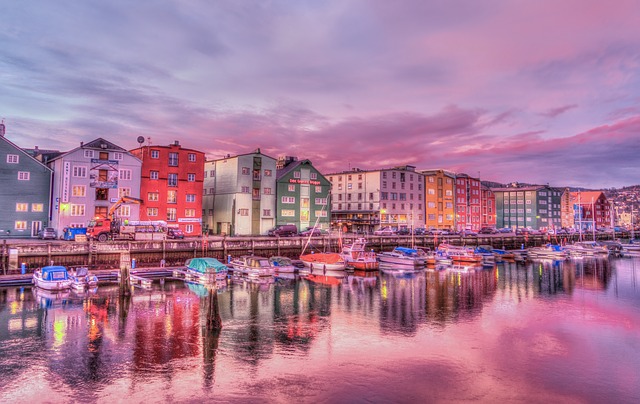
| Home » Region » Norway | |||
Norway
 GEIRANGER    Travel to NorwayNorway occupies the western half of the Scandinavian peninsula, stretching from Stavanger in the southwest to Finnmark in the Northeast, well above the Arctic Circle. Most of Norway's eastern border is shared with Sweden, though in the north both Finland and Russia are immediate neighbors. To the south lies the North Sea, and across it England and Denmark. Off Norway's spectacular western coast lies the Norwegian Sea and the Atlantic Ocean, and to the north is the Barents Sea and the Arctic. With an area of about 155,000 square miles, Norway is roughly the same size as California. Norway is long, narrow, and mountainous, with more than 30 per cent of its land covered by forests, rivers, and lakes. People of NorwayWith a population of just over four million, most of whom live in urban areas, Norwegians have plenty of room to move around. Some 40,000 Norwegians are Samis, an ethnic minority with a language and a culture all their own. Capital of NorwayOslo, with a population of about half a million people, is Norway's capital as well as its largest city. In addition to being the seat of the government, Oslo is the business and cultural capital of the nation. Government of NorwayNorway is a constitutional monarchy with a parliamentary system of government. King Harald V is the monarch; the prime minister is usually appointed from the ranks of the majority party. Norway's Parliament is called the "Stortinget." A member of NATO since 1949, Norway enjoys excellent relations with both the U.S. and Canada. Economy of NorwayNorwegians enjoy one of the world's highest per capita incomes. Oil and gas fields in the North Sea have for the past two decades been a cornerstone of the economy. Other major industries are fishing, pulp and paper, wood, mining, and shipping. More then 80 per cent of all Norwegian exports go to other Nordic countries and the European Union. History of NorwayNorway's history as a nation conventionally begins with the consolidation of its many small realms into a unified kingdom by Harold I, or Harold Fairhair, in the 9th century. Born around 850 AD, Harold succeeded his father Halfdan the Black as ruler of Vestfold, a region in southeastern Norway. Soon afterward, he initiated a series of campaigns against surrounding kingdoms, prompting--among other changes--a surge in Norse expeditions elsewhere in Europe. Thus, at the same time that Harold was celebrating his great victory at Hafrs Fjord in 872, the Norse were beginning to establish their presence in such places as England, Ireland, Iceland, and northern France. In France, the Norse quickly became known as the Normans, under which name they soon afterward conquered England. At about the same time, the Norse colonization of Iceland prepared the way for Eric the Red's settlement of Greenland and for Leif Ericson's arrival in North America around the year 1000AD. It was also during this eventful era that Christianity was brought to Norway by English missionaries. PRESS RELEASE DESTINATION SCORECARDNorway's western fjords top other World Heritage sites in National Geographic survey, as revealed in a press announcement in Washington DC October 2006. In a survey of the most popular World Heritage sites, Norway's western fjords emerged as the winner, in competition with other prestigious UNESCO sites, such as the Great Wall of China, Galapagos, the pyramids of Egypt, Grand Canyon, Angkor Wat and Machu Picchu. The Destination Scorecard Stewardship survey was organized by National Geographic Traveler and National Geographic Center for Sustainable Destinations. Detailed questionnaires were sent out to a panel of international experts who were asked to rank and reward places that have successfully managed to safeguard the characteristics for which the sites were originally granted World Heritage status by UNESCO. Such efforts, according to National Geographic, reflect the spirit of geotourism, which National Geographic defines as "tourism that sustains or enhances the geographical character of the place being visited, its environment, culture, aesthetics, heritage, and the well-being of its residents." "This seems to confirm that Norwegians tend to take excellent care of their places compared to the rest of the world. These are skills that leaders in other places would do well to study and adapt to their own situations," says Jonathan B. Tourtellot, Director, Center for Sustainable Destinations, National Geographic Society If you have any questions related with travel to Norway or any Norway tours, don't hesitate to call us at 1-800-223-7226 or e-mail info@scantours.net |












